What to do if carrots don’t grow: what is the best way to feed them and how to do it correctly
If carrots grow poorly on your site, the roots are uneven, deformed, thin and are not stored all winter, you should deal with this problem in the new season.
From the article you will learn what factors to avoid when caring for the plant and what fertilizers are needed for carrots so that the harvest is rich and well stored until spring.
For what reasons do carrots grow poorly?
Carrots are a capricious crop. Let's look at the reasons why carrots grow poorly or don't grow at all.
Improper care
Carrots should not be planted in dense soil, such as clay.. If the soil in your garden is too hard, it may be worth preparing it for planting. To do this, river sand is poured onto the top layer in a proportion of 12 kg per m² until the soil becomes loose. Before adding sand, the ground is dug up with a shovel full, loosened, and leveled with a rake.
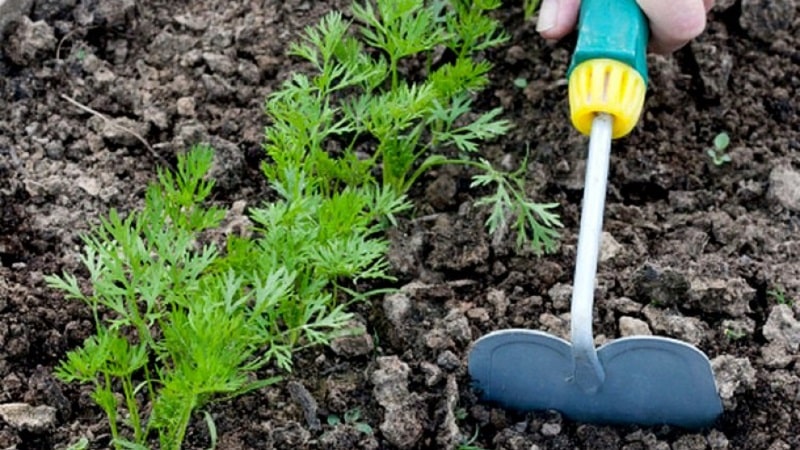
The soil is kept loose throughout the growth of carrots. If the soil is dense, all the seeds will not sprout. Loosen the soil as soon as seedlings appear and after each rain or watering.
Hill up carrots when the soil is wet. The first hilling is carried out when the top part of the carrot protruding from the ground has become clearly visible.
Important! Without hilling, the top part of the carrots begins to turn green - this is the accumulation of corned beef substance, which is dangerous to humans.
Adverse weather conditions
Optimal air temperature for the development and growth of carrots is +18…+24°С. If it gets hotter, carrots grow worse. To cool the soil in the evening, you can lay a hose between the rows and let water flow to a depth of 2-3 cm. This will lower the temperature of the soil by a couple of degrees, and the carrots will begin to grow again.
Wrong landing pattern
A bed for carrots is prepared out of the blue in the fall, without slopes, depressions and located from north to south. The width of the bed is 1 m, there are grooves on it 5 cm wide, 2 cm deep, the distance between the grooves is 18-20 cm. Before planting, spill a pink solution of potassium permanganate and moisten with water at room temperature. The seeds are scattered in a groove 1 cm apart.
Important! Before sowing, the seeds are kept in water for a day to swell.
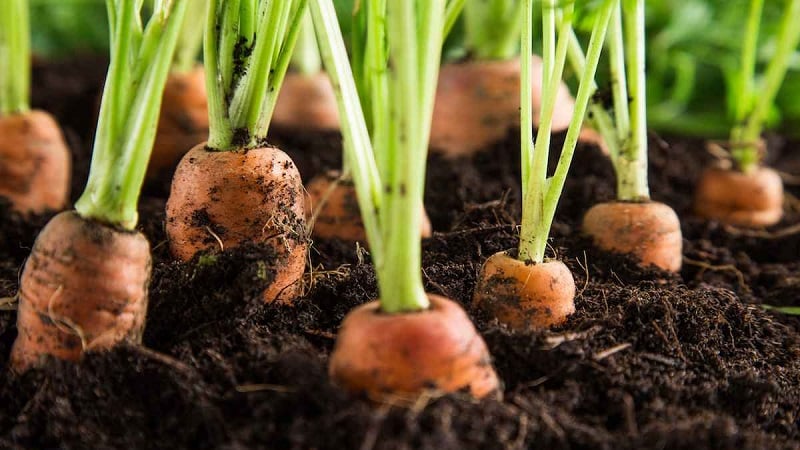
Crop rotation violations
You can sow carrots in the same place after 2-3 years. The best growth is observed when sowing after cucumbers, potatoes, onions, garlic, cabbage, and tomatoes. It is better not to plant vegetables after parsley and lettuce; they have common pests.
Excess or lack of light
Carrots not only love warm weather, but also the sun. Even a short-term shadow will have a bad effect on its growth. Each root vegetable must be illuminated. It is better to plant tall plants, such as corn, on the north side so that they do not shade the vegetable bed.
Interesting things on the site:
Improper watering
Carrots produce good yields in light to moderately moist soils. If the soil is dry or excessively soggy, the vegetable will not grow. There should be enough moisture during the period of active growth. Before harvesting, reduce the intensity of watering so that the carrots do not crack or rot.
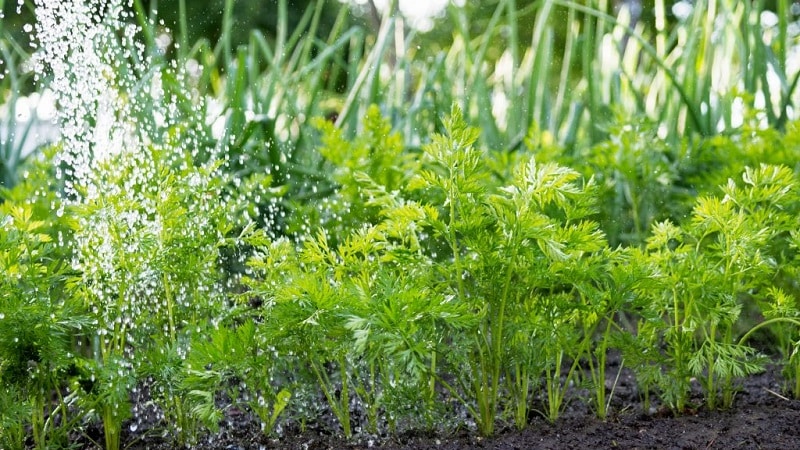
Diseases and pests
The table shows main diseases and pests of carrots and ways to combat them.
| Name | How to find out | How to fight, prevention |
| Diseases | ||
| Fomoz, dry rot | At the end of the growing season, oblong gray-brown spots appear on the leaves and petioles. After harvesting, root crops, when stored indoors at temperatures above 10°C, develop black-brown depressions with a whitish coating on the upper part. They grow and the entire vegetable is affected. | All affected plants must be removed. For prevention, phosphorus-potassium fertilizers are applied before planting.
|
| White rot | Affects carrot roots. When stored, they become soft and covered with a fluffy white coating, and then a crust with black dots.
|
To prevent spread to the ground, all weeds are removed in a timely manner. For prevention, potassium fertilizers are applied and sprayed with copper preparations. The storage room for vegetables is washed with disinfectants. |
| Gray rot | The surface of the root crop becomes soggy and dark during storage. and becomes covered with fungus.
|
For prevention, the soil is fed with nitrogen fertilizers and sprayed with a 1% solution of Bordeaux mixture. Store the harvest at a temperature of +2°C. |
| Rhizoctoniosis, or felt rot
|
It affects carrots during the period of active growth or during storage of the crop. Dark gray internal spots appear on the root crops, which then develop a purple felt coating and black dots. | The disease is treated at the stage of active growth of the vegetable by spraying with preparations containing copper oxychloride. |
| Alternaria, or black rot
|
It can occur at any stage of plant development. The stem turns black, the leaves curl, turn yellow and dry, and dry black rot forms on the root crop. | They get rid of the disease by spraying with the drug “Rovral”. |
| Bacteriosis
|
Yellow spots appear on the edges of the lower leaves, they darken, but the yellow outlines around them remain. Bacterial exudate is observed at the base of the leaves: gray-white or light yellow drops. There are brown spots or stripes on the stem. Ulcers and brown spots appear on root crops. The plant emits a strong, unpleasant odor. | The affected planting is completely removed. Prevention - soak the seeds in hot water before planting. Spray the seedlings with the preparation "HOM". |
| Cercospora
|
Light brown spots appear on the leaf blade with a gradually growing light center. At high humidity they become covered with plaque. The edges of the leaves curl, the greenery dies, the fruits remain small and do not grow. | Prevention - treating seeds before planting in hot water, spraying shoots with a solution of Bordeaux mixture.
|
| Brown spot
|
It affects the plant at all stages of development. Young shoots develop brown constrictions on the lower part of the stem. The leaves of adult plants become covered with yellow spots, which turn black or brown; with high humidity, a black coating forms on them. | Prevention - in rainy weather, regularly loosen the rows and treat the plants with a decoction of celandine, horsetail or nettle. |
| Pests | ||
| carrot fly
|
Affects root crops. The tops acquire a bronze tint, dry out and die. | Prevention - regularly loosen the soil and weed the ridges. Treated with chemicals “Decis Profi”, “Aktellik”, “Shar Pei” or sprinkled with ammonia |
| psyllid
|
The females of the pest lay eggs on the tops, their larvae feed on the sap of the leaves, causing the plant to dry out. | Insect eggs are collected and the beds are treated with soapy water or tobacco dust. |
| Umbrella moth
|
It infects carrot tops and spins cocoons on them, which feed on plant juices before turning into pupa. The greens darken, the roots dry out. | To remove pupae, the above-ground part of the plant along with them is cut off and destroyed. Spray carrots with Entobacterin or Lepidocide. For prevention, dig the soil deeply before planting. |
| Naked slugs
|
They start from high humidity. They eat through leaves and eat holes in root vegetables, leaving behind a shiny, sticky trail. | Prevention – treatment with “Superphosphate” or 10% salt solution.
|
| Wireworms
|
These are yellow worms 3 cm long - the larvae of the click beetle. They feed on root crops, eating punctures in them. | Get rid of the pest using ammonia fertilizer. The drugs “Bazudin” and “Aktara” help. |
| carrot aphid
|
Small green insects accumulate on the leaves of the plant. The greens curl and dry out due to the fact that aphids feed on stem sap. Small carrots stop developing. | They get rid of the pest by spraying the plantings with soapy water, tobacco infusion or ash. For prevention on hot days, carrots are irrigated with warm water. |
| exclamation scoop
|
The insect feeds on the root part of stems and root crops, making holes and passages. | The pest is removed using the chemicals “Polytrin”, “Decis” and “Fury” or sprayed with infusions of chamomile and burdock. |
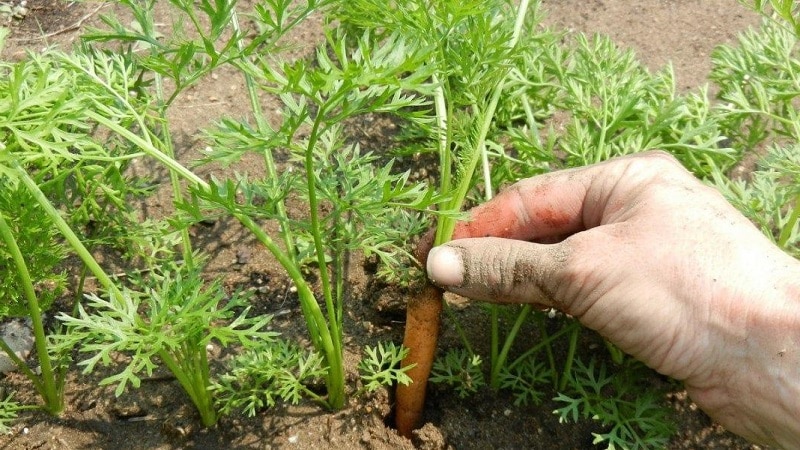
Sowing too thick
All sprouted shoots are thinned out so that the carrots are larger and juicier. The first time was when 2 true leaves appeared, the second time was two weeks later. Between shoots leave 4-6 cm of free surface.The soil should be kept moist during thinning.
Attention! Pull out the carrot carefully by the tail, taking it as close to the base as possible.
Other
Short and small varieties ripen faster. Long and thick root vegetables ripen in the time promised on the packaging, only under ideal weather conditions and care. They often grow slowly and are poorly stored.
Plant carrots in clay soil to a depth of 1 cm, in sandy soil - 4-5 cm. This way the seeds warm up, germinate well, and moisture reaches them in the right amount.
Substances necessary for carrot growth
Mineral fertilizers, especially nitrogen, potassium and phosphorus, are well accepted by carrots. They are introduced at different periods of growth, but not at the same time.
Nitrogen
It is the building material of protein compounds, which determines the crop yield. Macroelement is a component of chlorophyll, without which photosynthesis is impossible. With an excess or lack of nitrogen, the leaves turn yellow and curl.
To saturate carrots with nitrogen, use ammonium nitrate, urea, urea, and ammonium sulfate.
Nitrogen fertilizers are applied in spring and summer, incorporating them into the soil.
Attention! Follow the application rules indicated on the packaging so that excess nitrogen does not accumulate in the root crop in the form of nitrates.
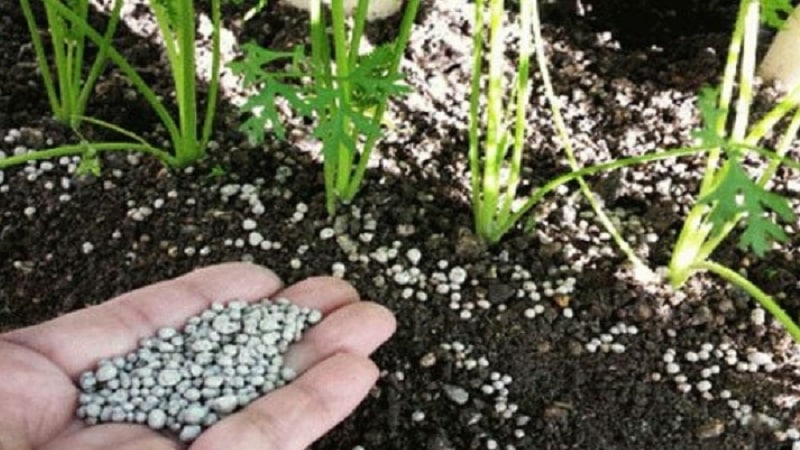
Potassium
Concentrated in young vegetable cells, synthesizes sugar. Increases drought resistance, frost resistance, participates in respiration and water metabolism of carrots. If a carrot lacks potassium, ammonia accumulates in its cells, which leads to the death of shoots and instability to fungal diseases.
Potassium deficiency is replenished with water-soluble fertilizers: potassium chloride, potassium sulfate, potassium nitrate, potassium magnesium.
Phosphorus
Forms a powerful root system and increases productivity. If a plant lacks phosphorus, its leaves turn bluish-green. Phosphorus fertilizers for carrots: “Superphosphate” and phosphate rock.
How to feed carrots if they do not grow well in open ground
The following types of organic fertilizers are used::
- Green manure for carrots (compost and humus), as well as peat and manure, are applied in the fall;
- bird droppings are diluted in water 1:10, left for a day, then diluted again in the same proportion - fed with the infusion at the beginning of plant growth;
- crushed eggshells are scattered after the first entrances appear, it supplies the plant with calcium and potassium;
- sprinkle with ash before feeding with phosphorus or potassium - it neutralizes acidic soil.
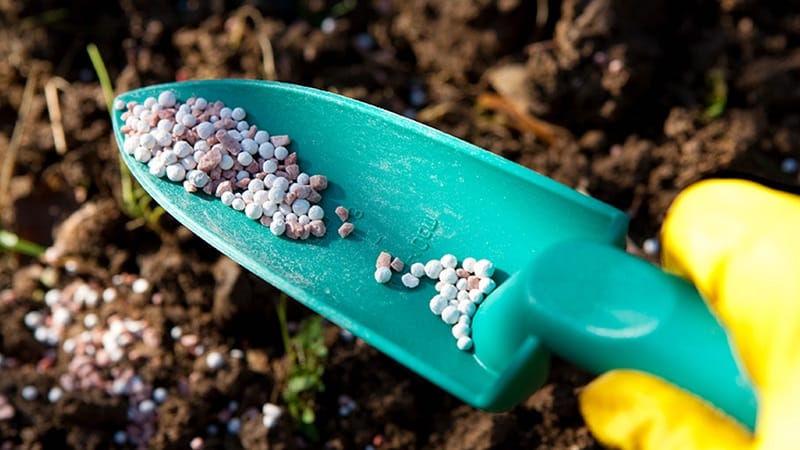
Check soil pH with litmus paper. Dissolve the soil in a glass of water, dip the test strip and compare the color with the scale on the package. The ideal soil pH for carrots is 6-7.
Mineral and complex fertilizers:
- Urea is a mineral fertilizer that contains nitrogen, which improves the growth of green mass in the first months.
- "Tsitovit." The main components of the fertilizer are nitrogen, phosphorus and potassium. The product is used for feeding, preventing diseases and protecting against pests. Use the Cytovit solution to soak the seeds: 3-4 drops of the drug per 100 g of water. Leave the seeds for 1-2 hours. Carrots sprout 2-3 days earlier than what is written on the package.
- “Ava” is a fertilizer made from lava mass, half of its composition is phosphorus, the rest is potassium, calcium, magnesium, chromium and other trace elements. Dissolve 4 g in 1 liter of water and water the soil.
What to feed after germination? Complex mineral fertilizers: “Nitrophoska”, “Rastvorin” and “Kemira” are suitable, they contain calcium, potassium, magnesium, phosphorus, nitrogen and other substances useful for plant development.
Read also:
Early maturing carrot hybrid with sweet taste Nandrin f1
Folk remedies
What to feed if carrots don’t grow, but you don’t want to use chemicals or buy organics? Folk remedies are no less effective than mineral and pure organics.
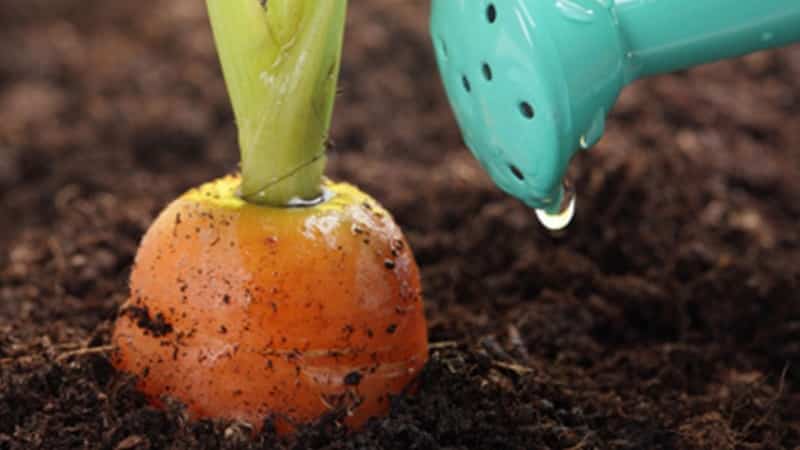
Here are a few recipes for feeding::
- Take a container of any size, fill it to the top with chopped nettle branches, add 2-5 cups of ash and 100 g of yeast. Fill to the top with water and leave for 5 days. 1 liter of product is diluted with 10 liters of water, poured under each root.
- Freshly cut nettle leaves are crushed, placed in a container and filled with warm water. The solution is left to ferment in the sun for 2 weeks and stirred daily. Before feeding, the infusion is diluted with water 1:10.
- 100 g of yeast are dissolved in a bucket of water and left for 1.5 hours. The beds are watered with infusion. The recipe is suitable for unfriendly shoots and as food during the period of active growth.
How to apply fertilizers correctly and in what quantities
You need to feed the soil for carrots before planting and throughout its growth.
When preparing the soil for planting
In the fall, when digging up the soil, fertilizing is carried out:
- For loamy soils, scatter 3 kg of sawdust per 1 m², soaked in a urea solution for 24 hours. From above, half a bucket of sand and 100 g of lime, “Superphosphate” and potassium fertilizers are added to the same area.
- For sandy soils, scatter a bucket of peat and humus per 1 m².
After applying fertilizers, the soil is dug up. The soil is sifted if it does not become loose after digging.
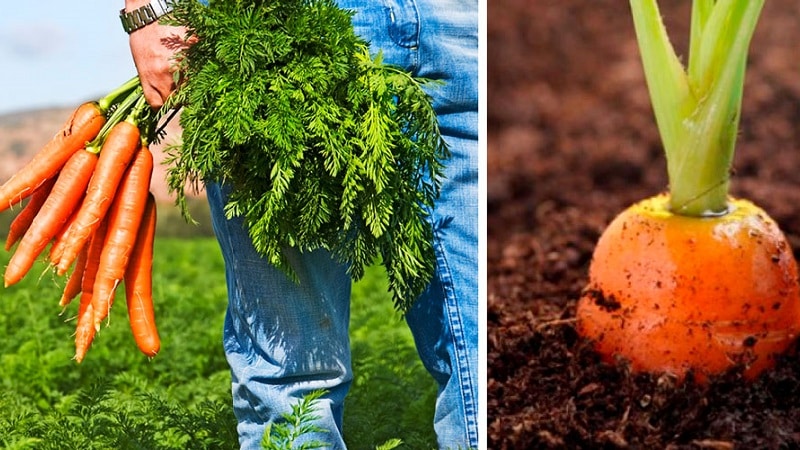
During sowing
Sprinkle the ridges with dolomite flour or wood ash. Ash reduces soil acidity, contains phosphorus and potassium, and protects against diseases. Before planting, 200 g of superphosphate, 100 g of potassium fertilizer and 50 g of sodium nitrate are added per 1 m². Lime is poured on top at a rate of 100 g per 1 m² for better absorption of fertilizers.
In the process of growing
During the growing season and growth of carrots, several feedings are done. All Root dressings should be liquid; they should be poured between the rows:
- First feeding: 150 g of mineral fertilizers per 1 m², of which phosphorus – 40 g, potassium – 60 g, nitrogen – 50 g.
- The second feeding after 2-3 weeks to maintain active plant growth: ammonium nitrate – 20 g, “Superphosphate” and potassium chloride – 30 g each.
- A month after germination, they are shed with a solution of “Nitroammofoski” or “Nitrofoski” in a ratio of 1 tbsp. l. for 10 liters of water. Repeat after 2-3 weeks at the rate of 7 liters per 1 m².
Feeding for late varieties during the period of active growth should consist of nitrogen fertilizers.
Attention! Mineral mixtures are applied after deep watering or rain.
Rules for fertilizing
When feeding it is important to follow the recommendations of experienced gardeners:
- Before feeding carrots, water the rows and inter-rows generously with water or wait until it rains, and then apply fertilizer.
- The last feeding of the root crop is a month before harvest, in August or September. It reduces the amount of nitrates that have accumulated in root vegetables, makes them sweet, tasty, juicy and increases shelf life.
Conclusion
It is recommended to prepare beds for planting carrots in the fall: choose a suitable place and apply fertilizer. Carrots love sandy, loose soil, sun, warmth and timely watering.Without fertilizing, it will not be possible to get juicy, sweet and large root vegetables. Choose what to fertilize, depending on the composition of the soil, the growth phase of the plant, follow the rules for applying fertilizing, then the carrots will grow large, of the correct shape and will be stored until spring.